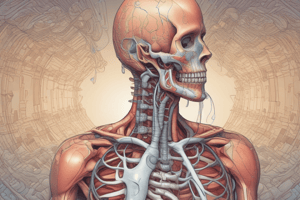Podcast
Questions and Answers
Which airway generations comprise the conducting zones?
Which airway generations comprise the conducting zones?
0 (trachea) to 16 (terminal bronchiole)
Which airway generations comprise the respiratory zones?
Which airway generations comprise the respiratory zones?
17 (respiratory bronchiole) to 23 (alveolar sac)
Where does gas exchange take place?
Where does gas exchange take place?
In the alveoli
Does the conducting zone take part in gas exchange?
Does the conducting zone take part in gas exchange?
What is the dead space?
What is the dead space?
What is the anatomical dead space?
What is the anatomical dead space?
What is the physiological dead space?
What is the physiological dead space?
What is the difference between anatomical and physiological dead space?
What is the difference between anatomical and physiological dead space?
What comprises physiological dead space?
What comprises physiological dead space?
What is alveolar dead space?
What is alveolar dead space?
How to measure the physiological dead space?
How to measure the physiological dead space?
How to measure the physiological dead space?
How to measure the physiological dead space?
Study Notes
Conducting and Respiratory Zones
- Conducting zones include airway generations from 0 (trachea) to 16 (terminal bronchiole).
- Respiratory zones consist of airway generations from 17 (respiratory bronchiole) to 23 (alveolar sac).
Gas Exchange
- Gas exchange occurs in the alveoli, which are found exclusively in the respiratory zone.
Conducting Zone and Gas Exchange
- The conducting zone does not participate in gas exchange, acting as an anatomical dead space where incoming tidal volume does not reach alveoli.
Dead Space Definition
- Dead space refers to the portion of inhaled tidal volume that remains in the conducting airways without entering the alveolar space, thus not participating in gas exchange.
Anatomical Dead Space
- Anatomical dead space is defined as the volume of air contained within the conducting airways.
Physiological Dead Space
- Physiological dead space comprises the portion of inhaled tidal volume that does not facilitate gas exchange and the portion of exhaled tidal volume that fails to eliminate carbon dioxide.
Comparison of Dead Spaces
- In healthy lungs, anatomical and physiological dead spaces are generally similar.
- In patients with chronic lung disease, physiological dead space can be significantly elevated.
Components of Physiological Dead Space
- Physiological dead space is the sum of anatomical dead space and alveolar dead space.
Alveolar Dead Space
- Alveolar dead space occurs when alveolar capillaries are obstructed, as seen in conditions like pulmonary embolism, preventing effective gas exchange.
Measurement of Physiological Dead Space
- Physiological dead space can be measured by assessing the amount of carbon dioxide eliminated during a single tidal volume.
Studying That Suits You
Use AI to generate personalized quizzes and flashcards to suit your learning preferences.
Description
Test your knowledge on the airway generations and zones of the respiratory system with these flashcards based on Egan's Chapter 11. This quiz covers the conducting and respiratory zones, including where gas exchange occurs. Perfect for students looking to reinforce their understanding of respiratory anatomy.




